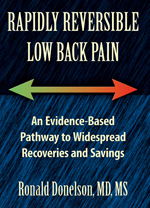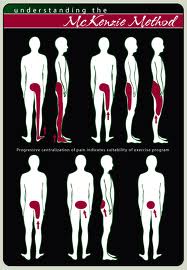Misconceptions on
McKenzie Concept:
The most basic, faulty assumption
made about the McKenzie Method is equating it with only
extension exercises – it is so much more.
The McKenzie Method is in its
truest sense, an assessment process that identifies responders and
non-responders in all populations. In cases when a patient does not
respond mechanically, alternative means of treatment or referral
for further medical evaluation is warranted. Also known as
Mechanical Diagnosis and Therapy, the McKenzie Method®
is a is a comprehensive approach to the spine and joints with a
philosophy of active patient involvement and education for back,
neck and extremity problems. This approach continues to be the most
researched physical therapy based method available. The key
distinction is its initial assessment component—a safe and reliable
means to accurately reach a diagnosis and only then make the
appropriate treatment plan. Rarely are expensive tests required,
Certified MDT clinicians have a valid indicator to know right away
whether—and how—the method will work for each patient.
Unique to the McKenzie Method, the
process begins with a thorough history and testing of movements to
identify distinct patterns of pain responses that are:
reproducible, objective, and reliable and reflect characteristics
of the underlying pain generator.
The most common and meaningful
pattern of pain response is Centralization, which
is well documented now in literature as both a diagnostic tool and
a prognostic indicator. This is defined as a patient’s referred or
radiating pain (whether just slightly off centre, into the buttock,
or all the way to the toes) promptly reversing, returning to the
centre of the back, and then usually also abolishing.
Centralization is clinically induced with clinically administered
postures, positions and repeated movements.
Whether the patient’s pain is
acute or chronic, if Centralization occurs through this logical
step by step assessment process, good outcomes are favorable in
acute to chronic patients. Centralization is independent of
non-organic and positive behavioral signs seen in chronic pain. It
provides a benefit to the patient and clinician by eliminating the
need for expensive &/or invasive procedures. Research has
evidenced that non-centralization is an early indicator of a
surgical outcome.
Ultimately, it provides a rational
guide to the most optimal treatment strategy for a specific
patient. A series of individualized exercises subsequent to the
patient’s responses during the assessment are prescribed and – most
critically – are based on the Directional
Preference that will centralize or abolish pain, i.e.
extension or flexion, right or left lateral movement, etc.
That is, Centralisation indicates Directional
preference.




